原发性头痛
- 格式:ppt
- 大小:284.50 KB
- 文档页数:62
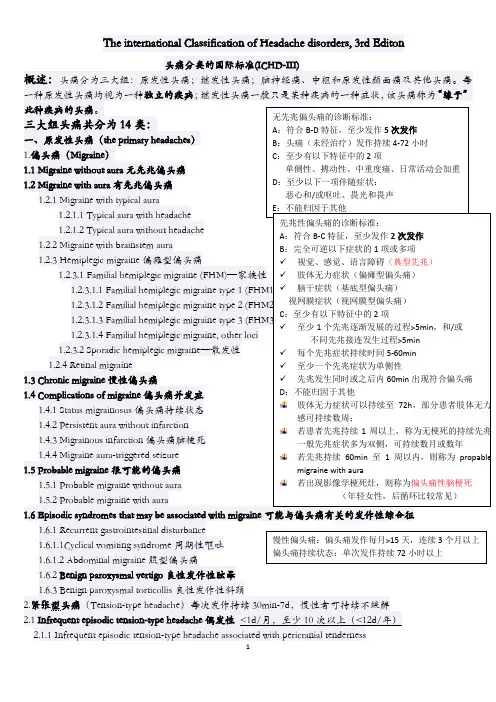
The international Classification of Headache disorders, 3rd Editon头痛分类的国际标准(ICHD-III)概述:头痛分为三大组:原发性头痛;继发性头痛;脑神经痛、中枢和原发性颜面痛及其他头痛。
每一种原发性头痛均视为一种独立的疾病;继发性头痛一般只是某种疾病的一种症状,该头痛称为“缘于”此种疾病的头痛。
三大组头痛共分为14类: 一、原发性头痛(the primary headaches ) 1.偏头痛(Migraine ) 1.1 Migraine without aura 无先兆偏头痛 1.2 Migraine with aura 有先兆偏头痛 1.2.1 Migraine with typical aura 1.2.1.1 Typical aura with headache 1.2.1.2 Typical aura without headache 1.2.2 Migraine with brainstem aura 1.2.3 Hemiplegic migraine 偏瘫型偏头痛1.2.3.1 Familial hemiplegic migraine (FHM)—家族性 1.2.3.1.1 Familial hemiplegic migraine type 1 (FHM1) 1.2.3.1.2 Familial hemiplegic migraine type 2 (FHM2) 1.2.3.1.3 Familial hemiplegic migraine type 3 (FHM3) 1.2.3.1.4 Familial hemiplegic migraine, other loci 1.2.3.2 Sporadic hemiplegic migraine —散发性 1.2.4 Retinal migraine 1.3 Chronic migraine 慢性偏头痛1.4 Complications of migraine 偏头痛并发症1.4.1 Status migrainosus 偏头痛持续状态 1.4.2 Persistent aura without infarction 1.4.3 Migrainous infarction 偏头痛脑梗死 1.4.4 Migraine aura-triggered seizure 1.5 Probable migraine 很可能的偏头痛 1.5.1 Probable migraine without aura1.5.2 Probable migraine with aura 1.6 Episodic syndromes that may be associated with migraine 可能与偏头痛有关的发作性综合征1.6.1 Recurrent gastrointestinal disturbance1.6.1.1Cyclical vomiting syndrome 周期性呕吐 1.6.1.2 Abdominal migraine 腹型偏头痛1.6.2 Benign paroxysmal vertigo 良性发作性眩晕1.6.3 Benign paroxysmal torticollis 良性发作性斜颈2.紧张型头痛(Tension-type headache )每次发作持续30min-7d ,慢性者可持续不缓解2.1 Infrequent episodic tension-type headache 偶发性 <1d/月,至少10次以上(<12d/年)2.1.1 Infrequent episodic tension-type headache associated with pericranial tenderness无先兆偏头痛的诊断标准:A :符合B-D 特征,至少发作5次发作B :头痛(未经治疗)发作持续4-72小时C :至少有以下特征中的2项单侧性、搏动性、中重度痛、日常活动会加重D :至少以下一项伴随症状:恶心和/或呕吐、畏光和畏声E :不能归因于其他 先兆性偏头痛的诊断标准:A :符合B-C 特征,至少发作2次发作B :完全可逆以下症状的1项或多项✓ 视觉、感觉、语言障碍(典型先兆)✓ 肢体无力症状(偏瘫型偏头痛)✓ 脑干症状(基底型偏头痛)视网膜症状(视网膜型偏头痛)C :至少有以下特征中的2项 ✓ 至少1个先兆逐渐发展的过程>5min ,和/或 不同先兆接连发生过程>5min ✓ 每个先兆症状持续时间5-60min✓ 至少一个先兆症状为单侧性✓ 先兆发生同时或之后内60min 出现符合偏头痛 D :不能归因于其他 肢体无力症状可以持续至72h ,部分患者肢体无力感可持续数周; 若患者先兆持续1周以上,称为无梗死的持续先兆一般先兆症状多为双侧,可持续数月或数年 若先兆持续60min 至1周以内,则称为propablemigraine with aura若出现影像学梗死灶,则称为偏头痛性脑梗死 (年轻女性,后循环比较常见) 慢性偏头痛:偏头痛发作每月>15天,连续3个月以上 偏头痛持续状态:单次发作持续72小时以上4.5 Cold-stimulus headache 冷刺激性头痛 4.5.1 Headache attributed to external application of a cold stimulus4.5.2 Headache attributed to ingestion or inhalation of a cold stimulus 4.5.3 Probable cold-stimulus headache4.5.3.1 Headache probably attributed to external application of a cold stimulus4.5.3.2 Headache probably attributed to ingestion or inhalation of a cold stimulus 4.6 External-pressure headache 4.6.1 External-compression headache 4.6.2 External-traction headache 4.6.3 Probable external-pressure headache4.6.3.1 Probable external-compression headache 4.6.3.2 Probable external-traction headache 4.7 Primary stabbing headache4.7.1 Probable primary stabbing headache4.8 Nummular headache4.8.1 Probable nummular headache4.9 Hypnic headache4.9.1 Probable hypnic headache4.10 New daily persistent headache (NDPH) 新症每日持续性头痛4.10.1 Probable new daily persistent headach 二、继发性头痛(the secondary headaches )5.缘于头、颈部外伤的头痛(Headache attributed to trauma or injury to the head and/or neck )5.1 Acute headache attributed to traumatic injury to the head5.1.1 Acute headache attributed to moderate or severe traumatic injury to the head5.1.2 Acute headache attributed to mild traumatic injury to the head5.2 Persistent headache attributed to traumatic injury to the head5.2.1 Persistent headache attributed to moderate or severe traumatic injury to the head5.2.2 Persistent headache attributed to mild traumatic injury to the head5.3 Acute headache attributed to whiplash5.4 Persistent headache attributed to whiplash5.5 Acute headache attributed to craniotomy5.6 Persistent headache attributed to craniotomy6.缘于头颈部血管疾病的头痛(Headache attributed to cranial or cervical vascular disorder )6.1 Headache attributed to ischaemic stroke or transient ischaemic attack6.1.1 Headache attributed to ischaemic stroke (cerebral infarction)6.1.2 Headache attributed to transient ischaemic attack (TIA)6.2 Headache attributed to non-traumatic intracranial haemorrhage6.2.1 Headache attributed to non-traumatic intracerebral haemorrhage 非外伤性脑出血6.2.2 Headache attributed to non-traumatic subarachnoid haemorrhage (SAH)6.2.3 Headache attributed to non-traumatic acute subdural haemorrhage (ASDH)急性硬膜下血肿NDPH 诊断标准: A :持续性头痛,符合B-C 的标准B :Distinct and clearly remembered onset, with pain becomingcontinuous and unremitting within 24 hours C :Present for>3 monthsD :除外其他疾患 慢性头痛,起病急,可清晰回忆发病时间为哪一天 疼痛缺乏特点,可以为偏头痛,可以为紧张性,亦可两者混合 若患者符合慢性偏头痛或慢性紧张型头痛的标准,则不诊断NDPH 若患者为药物过度使用性头痛,且符合NDPH 的标准, 则可两者均可作为诊断6.3 Headache attributed to unruptured vascular malformation 未破裂的血管畸形6.3.1 Headache attributed to unruptured saccular aneurysm囊性动脉瘤6.3.2 Headache attributed to arteriovenous malformation (AVM) 动静脉畸形6.3.3 Headache attributed to dural arteriovenous fistula (DAVF) 硬膜动静脉瘘6.3.4 Headache attributed to cavernous angioma 海绵窦血管瘤6.3.5 Headache attributed to encephalotrigeminal or leptomeningeal angiomatosis (Sturge Weber syndrome) 脑三叉神经或软脑膜血管瘤病6.4 Headache attributed to arteritis6.4.1 Headache attributed to giant cell arteritis (GCA) 颞动脉炎6.4.2 Headache attributed to primary angiitis of the central nervous system (PACNS)6.4.3 Headache attributed to secondary angiitis of the central nervous system (SACNS)颞动脉炎诊断标准:美国风湿学会1990年1. 50岁以上发病:50岁以上发现症状2.新发的头痛:出现新发的局限性头痛3.颞动脉异常:颞动脉压痛或者与颈动脉的动脉硬化无关的搏动减弱4.血沉值升高:50mm/h以上5.动脉活检异常:单核细胞为主的细胞浸润或者伴多核巨细胞的肉芽肿出现为特征的血管炎证据5项中如满足3项以上,敏感度93.5%。
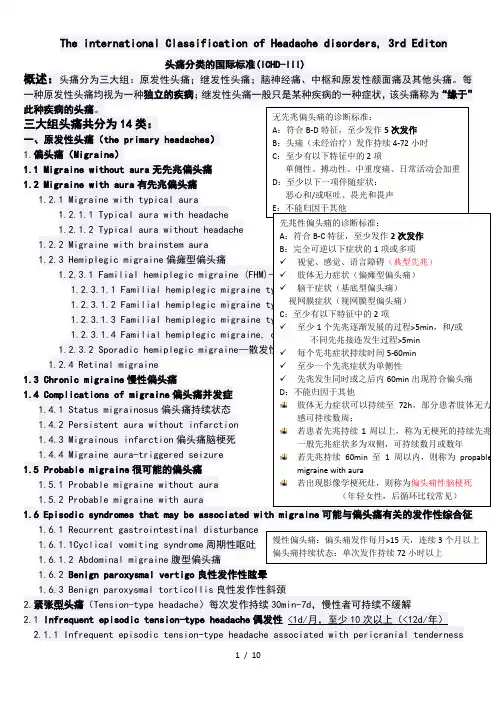
The international Classification of Headache disorders, 3rd Editon 头痛分类的国际标准(ICHD-III)概述:头痛分为三大组:原发性头痛;继发性头痛;脑神经痛、中枢和原发性颜面痛及其他头痛。
每一种原发性头痛均视为一种独立的疾病;继发性头痛一般只是某种疾病的一种症状,该头痛称为“缘于”此种疾病的头痛。
三大组头痛共分为14类: 一、原发性头痛(the primary headaches ) 1.偏头痛(Migraine ) 1.1 Migraine without aura 无先兆偏头痛 1.2 Migraine with aura 有先兆偏头痛 1.2.1 Migraine with typical aura1.2.1.1 Typical aura with headache 1.2.1.2 Typical aura without headache 1.2.2 Migraine with brainstem aura 1.2.3 Hemiplegic migraine 偏瘫型偏头痛1.2.3.1 Familial hemiplegic migraine (FHM)—家族性 1.2.3.1.1 Familial hemiplegic migraine type 1 (FHM1)1.2.3.1.2 Familial hemiplegic migraine type 2 (FHM2)1.2.3.1.3 Familial hemiplegic migraine type 3 (FHM3) 1.2.3.1.4 Familial hemiplegic migraine, other loci 1.2.3.2 Sporadic hemiplegic migraine —散发性 1.2.4 Retinal migraine 1.3 Chronic migraine 慢性偏头痛1.4 Complications of migraine 偏头痛并发症1.4.1 Status migrainosus 偏头痛持续状态 1.4.2 Persistent aura without infarction 1.4.3 Migrainous infarction 偏头痛脑梗死 1.4.4 Migraine aura-triggered seizure 1.5 Probable migraine 很可能的偏头痛 1.5.1 Probable migraine without aura1.5.2 Probable migraine with aura 1.6 Episodic syndromes that may be associated with migraine 可能与偏头痛有关的发作性综合征1.6.1 Recurrent gastrointestinal disturbance1.6.1.1Cyclical vomiting syndrome 周期性呕吐 1.6.1.2 Abdominal migraine 腹型偏头痛1.6.2 Benign paroxysmal vertigo 良性发作性眩晕1.6.3 Benign paroxysmal torticollis 良性发作性斜颈2.紧张型头痛(Tension-type headache )每次发作持续30min-7d ,慢性者可持续不缓解2.1 Infrequent episodic tension-type headache 偶发性 <1d/月,至少10次以上(<12d/年)2.1.1 Infrequent episodic tension-type headache associated with pericranial tenderness无先兆偏头痛的诊断标准:A :符合B-D 特征,至少发作5次发作B :头痛(未经治疗)发作持续4-72小时C :至少有以下特征中的2项单侧性、搏动性、中重度痛、日常活动会加重D :至少以下一项伴随症状:恶心和/或呕吐、畏光和畏声E :不能归因于其他 先兆性偏头痛的诊断标准:A :符合B-C 特征,至少发作2次发作B :完全可逆以下症状的1项或多项✓ 视觉、感觉、语言障碍(典型先兆)✓ 肢体无力症状(偏瘫型偏头痛)✓ 脑干症状(基底型偏头痛) 视网膜症状(视网膜型偏头痛) C :至少有以下特征中的2项 ✓ 至少1个先兆逐渐发展的过程>5min ,和/或 不同先兆接连发生过程>5min ✓ 每个先兆症状持续时间5-60min✓ 至少一个先兆症状为单侧性✓ 先兆发生同时或之后内60min 出现符合偏头痛 D :不能归因于其他 肢体无力症状可以持续至72h ,部分患者肢体无力感可持续数周; 若患者先兆持续1周以上,称为无梗死的持续先兆一般先兆症状多为双侧,可持续数月或数年若先兆持续60min 至1周以内,则称为propablemigraine with aura若出现影像学梗死灶,则称为偏头痛性脑梗死 (年轻女性,后循环比较常见) 慢性偏头痛:偏头痛发作每月>15天,连续3个月以上偏头痛持续状态:单次发作持续72小时以上4.3.1 Probable primary headache associated with sexual activity 4.4 Primary thunderclap headache 原发性霹雳头痛 4.5 Cold-stimulus headache 冷刺激性头痛 4.5.1 Headache attributed to external application of a cold stimulus4.5.2 Headache attributed to ingestion or inhalation of a cold stimulus4.5.3 Probable cold-stimulus headache 4.5.3.1 Headache probably attributed to external application of a cold stimulus4.5.3.2 Headache probably attributed to ingestion or inhalation of a cold stimulus4.6 External-pressure headache 4.6.1 External-compression headache 4.6.2 External-traction headache 4.6.3 Probable external-pressure headache4.6.3.1 Probable external-compression headache4.6.3.2 Probable external-traction headache 4.7 Primary stabbing headache 4.7.1 Probable primary stabbing headache 4.8 Nummular headache 4.8.1 Probable nummular headache4.9 Hypnic headache4.9.1 Probable hypnic headache4.10 New daily persistent headache (NDPH) 新症每日持续性头痛4.10.1 Probable new daily persistent headach 二、继发性头痛(the secondary headaches )5.缘于头、颈部外伤的头痛(Headache attributed to trauma or injury to the head and/or neck )5.1 Acute headache attributed to traumatic injury to the head5.1.1 Acute headache attributed to moderate or severe traumatic injury to the head5.1.2 Acute headache attributed to mild traumatic injury to the head5.2 Persistent headache attributed to traumatic injury to the head5.2.1 Persistent headache attributed to moderate or severe traumatic injury to the head5.2.2 Persistent headache attributed to mild traumatic injury to the head5.3 Acute headache attributed to whiplash5.4 Persistent headache attributed to whiplash5.5 Acute headache attributed to craniotomy5.6 Persistent headache attributed to craniotomy6.缘于头颈部血管疾病的头痛(Headache attributed to cranial or cervical vascular disorder )6.1 Headache attributed to ischaemic stroke or transient ischaemic attack6.1.1 Headache attributed to ischaemic stroke (cerebral infarction)6.1.2 Headache attributed to transient ischaemic attack (TIA)6.2 Headache attributed to non-traumatic intracranial haemorrhage6.2.1 Headache attributed to non-traumatic intracerebral haemorrhage 非外伤性脑出血6.2.2 Headache attributed to non-traumatic subarachnoid haemorrhage (SAH)NDPH 诊断标准:A :持续性头痛,符合B-C 的标准B :Distinct and clearly remembered onset, with pain becomingcontinuous and unremitting within 24 hours C :Present for>3 months D :除外其他疾患慢性头痛,起病急,可清晰回忆发病时间为哪一天 疼痛缺乏特点,可以为偏头痛,可以为紧张性,亦可两者混合若患者符合慢性偏头痛或慢性紧张型头痛的标准,则不诊断NDPH 若患者为药物过度使用性头痛,且符合NDPH 的标准, 则可两者均可作为诊断6.2.3 Headache attributed to non-traumatic acute subdural haemorrhage (ASDH)急性硬膜下血肿6.3 Headache attributed to unruptured vascular malformation未破裂的血管畸形6.3.1 Headache attributed to unruptured saccular aneurysm囊性动脉瘤6.3.2 Headache attributed to arteriovenous malformation (AVM) 动静脉畸形6.3.3 Headache attributed to dural arteriovenous fistula (DAVF) 硬膜动静脉瘘6.3.4 Headache attributed to cavernous angioma 海绵窦血管瘤6.3.5 Headache attributed to encephalotrigeminal or leptomeningeal angiomatosis (Sturge Weber syndrome)脑三叉神经或软脑膜血管瘤病6.4 Headache attributed to arteritis6.4.1 Headache attributed to giant cell arteritis (GCA) 颞动脉炎6.4.2 Headache attributed to primary angiitis of the central nervous system (PACNS)6.4.3 Headache attributed to secondary angiitis of the central nervous system (SACNS)颞动脉炎诊断标准:美国风湿学会1990年1. 50岁以上发病:50岁以上发现症状2.新发的头痛:出现新发的局限性头痛3.颞动脉异常:颞动脉压痛或者与颈动脉的动脉硬化无关的搏动减弱4.血沉值升高:50mm/h以上5.动脉活检异常:单核细胞为主的细胞浸润或者伴多核巨细胞的肉芽肿出现为特征的血管炎证据5项中如满足3项以上,敏感度93.5%。
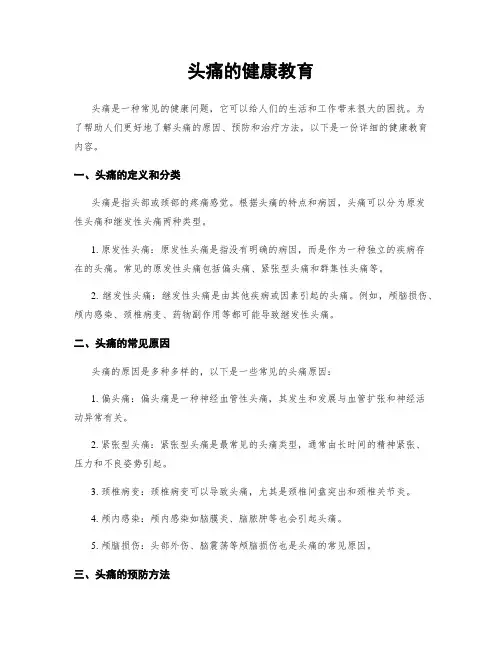
头痛的健康教育头痛是一种常见的健康问题,它可以给人们的生活和工作带来很大的困扰。
为了帮助人们更好地了解头痛的原因、预防和治疗方法,以下是一份详细的健康教育内容。
一、头痛的定义和分类头痛是指头部或颈部的疼痛感觉。
根据头痛的特点和病因,头痛可以分为原发性头痛和继发性头痛两种类型。
1. 原发性头痛:原发性头痛是指没有明确的病因,而是作为一种独立的疾病存在的头痛。
常见的原发性头痛包括偏头痛、紧张型头痛和群集性头痛等。
2. 继发性头痛:继发性头痛是由其他疾病或因素引起的头痛。
例如,颅脑损伤、颅内感染、颈椎病变、药物副作用等都可能导致继发性头痛。
二、头痛的常见原因头痛的原因是多种多样的,以下是一些常见的头痛原因:1. 偏头痛:偏头痛是一种神经血管性头痛,其发生和发展与血管扩张和神经活动异常有关。
2. 紧张型头痛:紧张型头痛是最常见的头痛类型,通常由长时间的精神紧张、压力和不良姿势引起。
3. 颈椎病变:颈椎病变可以导致头痛,尤其是颈椎间盘突出和颈椎关节炎。
4. 颅内感染:颅内感染如脑膜炎、脑脓肿等也会引起头痛。
5. 颅脑损伤:头部外伤、脑震荡等颅脑损伤也是头痛的常见原因。
三、头痛的预防方法预防头痛的发生是非常重要的,以下是一些常见的预防方法:1. 保持良好的生活习惯:保持规律的作息时间,避免熬夜和过度疲劳,保持充足的睡眠。
2. 避免诱发因素:了解自己的诱发因素,如特定的食物、气候变化、情绪波动等,尽量避免接触。
3. 控制压力:学会应对压力和紧张情绪,可以通过运动、放松技巧和心理咨询等方式来帮助缓解压力。
4. 饮食调节:合理饮食,避免暴饮暴食和过度饮酒,尽量避免摄入过多的咖啡因。
5. 保持适当的运动:适度运动可以改善血液循环和放松紧张的肌肉,有助于预防头痛的发生。
四、头痛的治疗方法当头痛发生时,及时采取合适的治疗方法可以缓解疼痛并防止症状恶化。
以下是一些常见的头痛治疗方法:1. 休息和放松:在头痛发作时,尽量找一个安静的环境休息,放松身心。
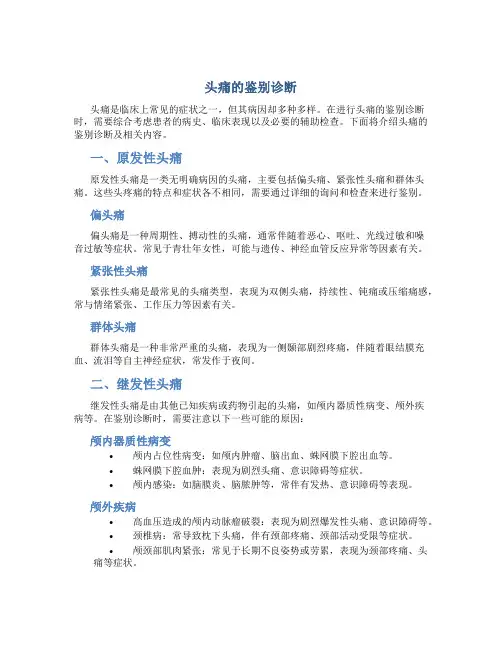
头痛的鉴别诊断头痛是临床上常见的症状之一,但其病因却多种多样。
在进行头痛的鉴别诊断时,需要综合考虑患者的病史、临床表现以及必要的辅助检查。
下面将介绍头痛的鉴别诊断及相关内容。
一、原发性头痛原发性头痛是一类无明确病因的头痛,主要包括偏头痛、紧张性头痛和群体头痛。
这些头疼痛的特点和症状各不相同,需要通过详细的询问和检查来进行鉴别。
偏头痛偏头痛是一种周期性、搏动性的头痛,通常伴随着恶心、呕吐、光线过敏和噪音过敏等症状。
常见于青壮年女性,可能与遗传、神经血管反应异常等因素有关。
紧张性头痛紧张性头痛是最常见的头痛类型,表现为双侧头痛,持续性、钝痛或压缩痛感,常与情绪紧张、工作压力等因素有关。
群体头痛群体头痛是一种非常严重的头痛,表现为一侧颞部剧烈疼痛,伴随着眼结膜充血、流泪等自主神经症状,常发作于夜间。
二、继发性头痛继发性头痛是由其他已知疾病或药物引起的头痛,如颅内器质性病变、颅外疾病等。
在鉴别诊断时,需要注意以下一些可能的原因:颅内器质性病变•颅内占位性病变:如颅内肿瘤、脑出血、蛛网膜下腔出血等。
•蛛网膜下腔血肿:表现为剧烈头痛、意识障碍等症状。
•颅内感染:如脑膜炎、脑脓肿等,常伴有发热、意识障碍等表现。
颅外疾病•高血压造成的颅内动脉瘤破裂:表现为剧烈爆发性头痛、意识障碍等。
•颈椎病:常导致枕下头痛,伴有颈部疼痛、颈部活动受限等症状。
•颅颈部肌肉紧张:常见于长期不良姿势或劳累,表现为颈部疼痛、头痛等症状。
三、其他原因除上述主要类型外,头痛还可能由其他因素引起,如眼部疾病、颞动脉炎、颞颌关节紊乱等。
在进行鉴别诊断时,需全面考虑患者的病史、临床表现和必要的检查结果,以明确病因并制定合理的治疗方案。
综上所述,头痛的鉴别诊断是一个复杂而重要的过程,需要综合考虑各种可能的病因和症状特点。
只有通过科学的方法和严谨的态度,才能更好地帮助患者解决头痛问题。
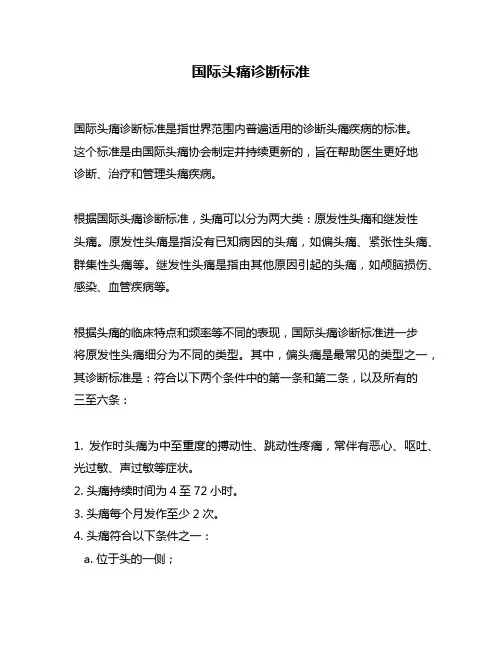
国际头痛诊断标准国际头痛诊断标准是指世界范围内普遍适用的诊断头痛疾病的标准。
这个标准是由国际头痛协会制定并持续更新的,旨在帮助医生更好地诊断、治疗和管理头痛疾病。
根据国际头痛诊断标准,头痛可以分为两大类:原发性头痛和继发性头痛。
原发性头痛是指没有已知病因的头痛,如偏头痛、紧张性头痛、群集性头痛等。
继发性头痛是指由其他原因引起的头痛,如颅脑损伤、感染、血管疾病等。
根据头痛的临床特点和频率等不同的表现,国际头痛诊断标准进一步将原发性头痛细分为不同的类型。
其中,偏头痛是最常见的类型之一,其诊断标准是:符合以下两个条件中的第一条和第二条,以及所有的三至六条:1. 发作时头痛为中至重度的搏动性、跳动性疼痛,常伴有恶心、呕吐、光过敏、声过敏等症状。
2. 头痛持续时间为4至72小时。
3. 头痛每个月发作至少2次。
4. 头痛符合以下条件之一:a. 位于头的一侧;b. 只在头的一侧或基本只在头的一侧;c. 在头的一侧或基本只在头的一侧,并且头痛的强度或质地在另一侧轻微或部分缺失。
5. 头痛符合以下条件之一:a. 伴有神经系统症状,如视觉障碍、感觉异常、肢体无力等;b. 引起注意力降低或狭窄;c. 发作前出现典型的神经系统症状,如视觉幻觉、口齿不清等。
6. 头痛不符合紧张性头痛、硬膜外血肿、颅内占位性病变、颅内炎症、颅内血管畸形等其他头痛疾病的诊断标准。
此外,国际头痛诊断标准还规定了其他原发性头痛的诊断标准,如紧张性头痛、群集性头痛、原发性咳嗽性头痛等。
继发性头痛的诊断要根据病因进行诊断,如头外伤引起的头痛、脑垂体瘤引起的头痛等。
在诊断头痛疾病时,医生需要仔细询问病史、观察头痛的临床表现、进行必要的检查和鉴别诊断,采用遵循国际头痛诊断标准的方法进行诊断,并针对性地进行治疗和管理。


罕见性原发性头痛目前对于归类为罕见性原发性头痛综合征的疾病知之甚少。
本文总结了罕见性原发性头痛综合征的临床表现、病理生理学、流行病学和治疗方法。
提高公众对不同类型的罕见性原发性头痛综合征的认识,可以更好地进行研究以及临床诊治。
近期国际头痛协会也更新了头痛的分类标准,增加了一些疾病实体,把其他一些疾病归到别的疾病分类中。
本文结论认为应该对所有怀疑患有罕见性原发性头痛的患者进行神经影像学检查,以排除继发性头痛的病因。
吲哚美辛治疗可能对某些疾病有效,但需要更大型的随机对照研究。
简介:当头痛疾病在普通人群中患病率低于 1% 的时候被认为是罕见性头痛。
在欧洲,罕见性头痛定义为患者人数不超过 1 万人。
对于大多数罕见性头痛疾病,真正的患病率仍然是未知的,或者只能依靠来自三级头痛中心的文献病例报告或者小规模队列研究。
国际头痛疾病分类 (ICHD;其他主要头痛,表 1) 第四章第一部分对部分头痛进行了总结。
表 1.罕见性原发性头痛的分类(ICHD-3 beta 版;第四章,第 637 页)4.1 原发性咳嗽性头痛4.2 原发性运动性头痛4.3 与性活动相关性原发性头痛4.4 原发性雷击样头痛4.5 冷刺激性头痛4.6 外部压力性头痛4.7 原发性刺痛性头痛4.8 硬币形头痛4.9 睡眠头痛4.10 新发每日持续性头痛 (NDPH)4.11 颅表逆向线性放射性头痛2013 年发表了新的 ICHD-3 beta 版本引进临床进行测试。
计划未来将会纳入国际疾病分类 (ICD-11) 中。
其中一些疾病分类为原发性头痛或者是重新进行了分类。
例如,钱币形头痛,从原来 ICHD-2 中附录部分上升到原发性头痛的分类,因为随着越来越多的证据表明它应当被当做原发性头痛。
冷刺激性头痛和外部压力性头痛从第 13 章分出,连续性半侧颅痛最终被分类为三叉神经自发性头痛 (TAC) 。
大多数的头痛也可能为继发性头痛,在日常门诊和急诊时都需要考虑到。
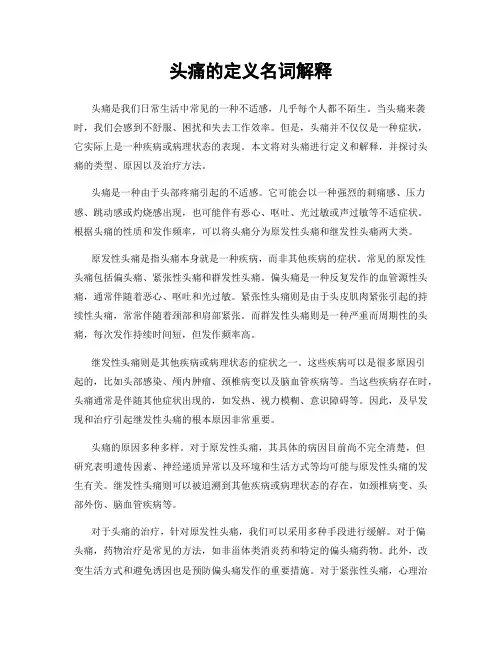
头痛的定义名词解释头痛是我们日常生活中常见的一种不适感,几乎每个人都不陌生。
当头痛来袭时,我们会感到不舒服、困扰和失去工作效率。
但是,头痛并不仅仅是一种症状,它实际上是一种疾病或病理状态的表现。
本文将对头痛进行定义和解释,并探讨头痛的类型、原因以及治疗方法。
头痛是一种由于头部疼痛引起的不适感。
它可能会以一种强烈的刺痛感、压力感、跳动感或灼烧感出现,也可能伴有恶心、呕吐、光过敏或声过敏等不适症状。
根据头痛的性质和发作频率,可以将头痛分为原发性头痛和继发性头痛两大类。
原发性头痛是指头痛本身就是一种疾病,而非其他疾病的症状。
常见的原发性头痛包括偏头痛、紧张性头痛和群发性头痛。
偏头痛是一种反复发作的血管源性头痛,通常伴随着恶心、呕吐和光过敏。
紧张性头痛则是由于头皮肌肉紧张引起的持续性头痛,常常伴随着颈部和肩部紧张。
而群发性头痛则是一种严重而周期性的头痛,每次发作持续时间短,但发作频率高。
继发性头痛则是其他疾病或病理状态的症状之一。
这些疾病可以是很多原因引起的,比如头部感染、颅内肿瘤、颈椎病变以及脑血管疾病等。
当这些疾病存在时,头痛通常是伴随其他症状出现的,如发热、视力模糊、意识障碍等。
因此,及早发现和治疗引起继发性头痛的根本原因非常重要。
头痛的原因多种多样。
对于原发性头痛,其具体的病因目前尚不完全清楚,但研究表明遗传因素、神经递质异常以及环境和生活方式等均可能与原发性头痛的发生有关。
继发性头痛则可以被追溯到其他疾病或病理状态的存在,如颈椎病变、头部外伤、脑血管疾病等。
对于头痛的治疗,针对原发性头痛,我们可以采用多种手段进行缓解。
对于偏头痛,药物治疗是常见的方法,如非甾体类消炎药和特定的偏头痛药物。
此外,改变生活方式和避免诱因也是预防偏头痛发作的重要措施。
对于紧张性头痛,心理治疗、放松训练等非药物治疗方法有效。
对于群发性头痛,针灸和特定药物有时可以缓解症状。
对于继发性头痛,治疗的重点在于针对潜在病因进行治疗,比如抗感染治疗、手术治疗等。

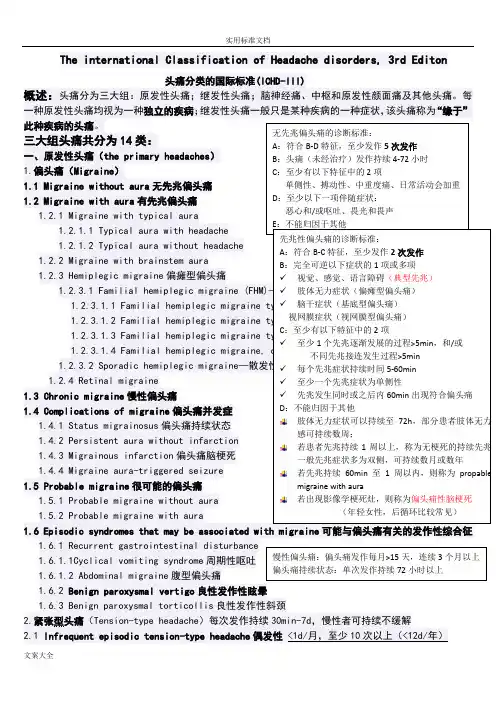
The international Classification of Headache disorders, 3rd Editon4.6.3.2 Probable external-traction headache 4.7.1 Probable primary stabbing headache6.2 Headache attributed to non-traumatic intracranial haemorrhage6.2.1 Headache attributed to non-traumatic intracerebral haemorrhage非外伤性脑出血6.2.2 Headache attributed to non-traumatic subarachnoid haemorrhage (SAH)6.2.3 Headache attributed to non-traumatic acute subdural haemorrhage (ASDH)急性硬膜下血肿6.3 Headache attributed to unruptured vascular malformation未破裂的血管畸形6.3.1 Headache attributed to unruptured saccular aneurysm囊性动脉瘤6.3.2 Headache attributed to arteriovenous malformation (AVM) 动静脉畸形6.3.3 Headache attributed to dural arteriovenous fistula (DAVF) 硬膜动静脉瘘6.3.4 Headache attributed to cavernous angioma 海绵窦血管瘤6.3.5 Headache attributed to encephalotrigeminal or leptomeningeal angiomatosis (Sturge Weber syndrome)脑三叉神经或软脑膜血管瘤病6.4 Headache attributed to arteritis6.4.1 Headache attributed to giant cell arteritis (GCA) 颞动脉炎6.4.2 Headache attributed to primary angiitis of the central nervous system (PACNS)6.4.3 Headache attributed to secondary angiitis of the central nervous system (SACNS)6.8.2 Mitochondrial Encephalopathy, Lactic Acidosis and Stroke-like episodes (MELAS)6.8.3 Headache attributed to another genetic vasculopathy6.9 Headache attributed to pituitary apoplexy垂体卒中7.缘于非血管性颅内疾病的头痛(Headache attributed to non-vascular intracranial disorder )7.1 Headache attributed to increased cerebrospinal fluid pressure颅内压增高7.1.1 Headache attributed to idiopathic intracranial hypertension (IIH)7.1.2 Headache attributed to intracranial hypertension secondary to metabolic, toxic or hormonal causes7.1.3 Headache attributed to intracranial hypertension secondary to hydrocephalus7.2 Headache attributed to low cerebrospinal fluid pressure颅内压低下7.2.1 Post-dural puncture headache腰穿后7.2.2 CSF fistula headache脑脊液漏7.2.3 Headache attributed to spontaneous intracranial hypotension自发性低颅压7.3 Headache attributed to non-infectious inflammatory disease非感染性炎性疾病7.3.1 Headache attributed to neurosarcoidosis7.3.2 Headache attributed to aseptic (non-infectious) meningitis7.3.3 Headache attributed to other non-infectious inflammatory disease7.3.4 Headache attributed to lymphocytic hypophysitis7.3.5 Syndrome of transient Headache and Neurological Deficits with cerebrospinal fluid Lymphocytosis (HaNDL)7.4 Headache attributed to intracranial neoplasia颅内新生物7.4.1 Headache attributed to intracranial neoplasm7.4.1.1 Headache attributed to colloid cyst of the third ventricle7.4.2 Headache attributed to carcinomatous meningitis癌性脑膜炎7.4.3 Headache attributed to hypothalamic or pituitary hyper- or hyposecretion7.5 Headache attributed to intrathecal injection鞘内注射7.6 Headache attributed to epileptic seizure7.6.1 Hemicrania epileptica癫痫半颅痛7.6.2 Post-ictal headache癫痫发作后头痛7.7 Headache attributed to Chiari malformation type I (CM1)7.8 Headache attributed to other non-vascular intracranial disorder8.缘于物质或物质戒断的头痛(Headache attributed to a substance or its withdrawal)8.1 Headache attributed to use of or exposure to a substance or its withdrawal缘于某种物质的应用或戒断8.1.1 Nitric oxide (NO) donor-induced headache一氧化氮诱发8.1.1.1 Immediate NO donor-induced headache8.1.1.2 Delayed NO donor-induced headache8.1.2 Phosphodiesterase (PDE) inhibitor-induced headache磷酸二酯酶抑制剂8.1.3 Carbon monoxide (CO)-induced headache一氧化碳诱发8.1.4 Alcohol-induced headache酒精诱发8.3.4 Headache attributed to withdrawal from chronic use of other substance9.缘于感染的头痛(Headache attributed to infection)9.1 Headache attributed to intracranial infection颅内感染9.1.1 Headache attributed to bacterial meningitis or meningoencephalitis细菌性脑膜炎/脑膜脑炎9.1.1.1 Acute headache attributed to bacterial meningitis or meningoencephalitis9.1.1.2 Chronic headache attributed to bacterial meningitis or meningoencephalitis9.1.1.3 Persistent headache attributed to past bacterial meningitis or meningoencephalitis9.1.2 Headache attributed to viral meningitis or encephalitis病毒性脑膜炎或脑炎9.1.2.1 Headache attributed to viral meningitis9.1.2.2 Headache attributed to viral encephalitis9.1.3 Headache attributed to intracranial fungal or other parasitic infection真菌或寄生虫感染9.1.3.1 Acute headache attributed to intracranial fungal or other parasitic infection9.1.3.2 Chronic headache attributed to intracranial fungal or other parasitic infection9.1.4 Headache attributed to brain abscess脑脓肿9.1.5 Headache attributed to subdural empyema硬膜下积脓9.2 Headache attributed to systemic infection系统感染9.2.1 Headache attributed to systemic bacterial infection系统细菌感染9.2.1.1 Acute headache attributed to systemic bacterial infection9.2.1.2 Chronic headache attributed to systemic bacterial infection9.2.2 Headache attributed to systemic viral infection系统病毒感染9.2.2.1 Acute headache attributed to systemic viral infection9.2.2.2 Chronic headache attributed to systemic viral infection9.2.3 Headache attributed to other systemic infection其他系统感染9.2.3.1 Acute headache attributed to other systemic infection9.2.3.2 Chronic headache attributed to other systemic infection10.缘于内环境紊乱的头痛(Headache attributed to disorder of homoeostasis)10.1 Headache attributed to hypoxia and/or hypercapnia缺氧和/或高碳酸血症10.1.1 High-altitude headache高海拔头痛10.1.2 Headache attributed to aeroplane travel飞行头痛10.1.3 Diving headache潜水头痛10.1.4 Sleep apnoea headache睡眠呼吸暂停性头痛10.2 Dialysis headache10.3 Headache attributed to arterial hypertension高血压性头痛10.3.1 Headache attributed to phaeochromocytoma嗜络细胞瘤10.3.2 Headache attributed to hypertensive crisis without hypertensive encephalopathy无高血压脑病的高血压危象10.3.3 Headache attributed to hypertensive encephalopathy高血压脑病10.3.4 Headache attributed to pre-eclampsia or eclampsia先兆子痫10.3.5 Headache attributed to autonomic dysreflexia自主反射障碍10.4 Headache attributed to hypothyroidism甲状腺低下10.5 Headache attributed to fasting禁食10.6 Cardiac cephalalgia心源性头痛10.7 Headache attributed to other disorder of homoeostasis其他内环境稳定失调疾患11.缘于头、颈、眼、耳、鼻、鼻窦、牙、口或其他头面部结构病变的头面痛(Headache or facial pain attributed to disorder of the cranium, neck,eyes, ears, nose, sinuses, teeth, mouth or other facial or cervical structure )11.1 Headache attributed to disorder of cranial bone颅骨11.2 Headache attributed to disorder of the neck 颈部11.2.1 Cervicogenic headache11.2.2 Headache attributed to retropharyngeal tendonitis11.2.3 Headache attributed to craniocervical dystonia11.3 Headache attributed to disorder of the eyes眼睛11.3.1 Headache attributed to acute glaucoma急性青光眼11.3.2 Headache attributed to refractive error屈光不正11.3.3 Headache attributed to heterophoria or heterotropia (latent or persistent squint)斜视11.3.4 Headache attributed to ocular inflammatory disorder11.3.5 Headache attributed to trochleitis11.4 Headache attributed to disorder of the ears耳朵11.5 Headache attributed to disorder of the nose or paranasal sinuses鼻子或鼻窦11.5.1 Headache attributed to acute rhinosinusitis急性鼻窦炎11.5.2 Headache attributed to chronic or recurring rhinosinusitis11.6 Headache attributed to disorder of the teeth or jaw11.7 Headache attributed to temporomandibular disorder (TMD)11.8 Head or facial pain attributed to inflammation of the stylohyoid ligament11.9 Headache or facial pain attributed to other disorder of cranium, neck, eyes, ears, nose,sinuses, teeth, mouth or other facial or cervical structure12.缘于精神疾病的头痛(Headache attributed to psychiatric disorder)12.1 Headache attributed to somatization disorder躯体化障碍12.2 Headache attributed to psychotic disorder精神疾病三、脑神经痛、中枢和原发性颜面痛及其他头痛(painful cranial neuropathies, other facial pains and other headaches)13.脑神经痛和中枢性颜面痛(Painful cranial neuropathies and other facial pains)13.1 Trigeminal neuralgia三叉神经痛13.1.1 Classical trigeminal neuralgia13.1.1.1 Classical trigeminal neuralgia, purely paroxysmal13.1.1.2 Classical trigeminal neuralgia with concomitant persistent facial pain。
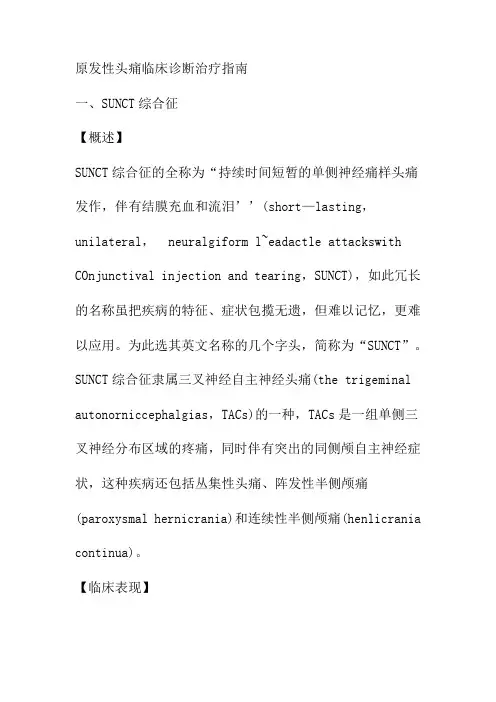
原发性头痛临床诊断治疗指南一、SUNCT综合征【概述】SUNCT综合征的全称为“持续时间短暂的单侧神经痛样头痛发作,伴有结膜充血和流泪’’(short—lasting,unilateral, neuralgiform l~eadactle attackswith COnjunctival injection and tearing,SUNCT),如此冗长的名称虽把疾病的特征、症状包揽无遗,但难以记忆,更难以应用。
为此选其英文名称的几个字头,简称为“SUNCT”。
SUNCT综合征隶属三叉神经自主神经头痛(the trigeminal autonorniccephalgias,TACs)的一种,TACs是一组单侧三叉神经分布区域的疼痛,同时伴有突出的同侧颅自主神经症状,这种疾病还包括丛集性头痛、阵发性半侧颅痛(paroxysmal hernicrania)和连续性半侧颅痛(henlicrania continua)。
【临床表现】SUNCT综合征不多见,可能是因对其认识不足。
发病年龄在50岁左右。
患者在整日头痛的基础上出现程度严重的阵发性头痛,疼痛局限于三叉神经第一支分布区,阵发性头痛发作时伴有颅部自主神经症状。
头痛一般在三叉神经分布的眼支最重,特别是在眼眶部,或眼眶周围、前额和颞部。
头痛发作只限于单侧。
疼痛的严重性介于中度到重度。
疼痛性质多描述为刺痛、烧灼性痛或电击样痛。
头痛发作时间短暂,持续时间介于5~250秒(平均49秒),偶可持续更长些。
阵发性头痛发作突然,在2~3秒内达到最大强度,然后维持在最大强度1分钟后作用突然停止。
多数患者于发作间隙期毫无症状,部分患者于间隙期可有头钝痛。
急性头痛发作时伴随多种头颅的自主神经症状,最多伴有的症状包括同侧结膜充血和流泪;较少见的有同侧鼻充血、流涕、眼睑水肿、眼睑下垂、瞳孔缩小、面部发红和出汗。
头痛发作时不伴有恶心、呕吐、畏光、畏声和烦躁不安等。
多数患者碰触三叉神经分布区可触发疼痛发作,偶尔碰触三叉神经分布以外的区域也能触发发作,如面的其他部位、头皮,剃胡须、吃饭、咀嚼、刷牙、谈话、咳嗽、颈部运动可触发发作,但有些患者能借连续旋转头部以减轻或中断发作。
3种常见头痛类型的特点!头痛指的是眉弓、耳廓上部和枕外隆突连线以上的疼痛,即通常说的头颅上半部的疼痛。
可能每个人都曾有过头痛的经历,但头痛的分类很多,病种也很多,在诊断头痛时首先要区分原发性头痛和继发性头痛,再就是需要医生详细的询问病史。
原发性头痛的常见类型原发性头痛临床上常见的主要有偏头痛、紧张性头痛和丛集性头痛,有调查显示紧张性头痛的发病率最高,依次为偏头痛和丛集性头痛,原发性头痛多为慢性且反复发作性的头痛,所以是门诊就诊最多见的头痛类型。
1、紧张性头痛发病时疼痛较轻,多为双侧紧箍感、胀感和压迫感,发病时往往患者处于精神紧张及应激情况下,如工作学习压力大、熬夜等情况下。
患者常常自诉头部要爆炸的感觉,每次发作时可以持续半小时到一周左右甚至长达数月,且一般不会伴随其他症状。
2、偏头痛可有先兆或无先兆症状,发病时疼痛较重,多为单侧搏动性疼痛及钝痛,伴恶心、呕吐等自主神经症状。
成人每次发病可以持续 4 ~ 72 小时,儿童及 12 ~ 17 岁的年轻患者每次发病可以持续 1 ~ 72 小时。
具有先兆症状的偏头痛可以出现闪光、暗点及黒矇感,有些患者还会出现如麻木、针刺样感觉异常。
3、丛集性头痛是三种常见原发性头痛中疼痛最重的疾病,疼痛多位于单侧眼眶、或沿着一侧的面部或头部,疼痛的性质也多种多样,如尖锐性、烧灼性及撕裂样剧烈疼痛,持续 15 分钟 ~ 3 小时左右。
它与上述两种疼痛的鉴别点还有发病时常常在疼痛部位的同侧出现眼睑肿胀、鼻塞、流鼻涕、面部出汗等症状。
以下情况要考虑继发性头痛1. 突发性剧烈疼痛:脑出血、蛛网膜下腔出血等。
2. 疼痛加重伴发热:颅内感染、颅脑外伤、脑肿瘤、鼻旁窦炎、中耳炎等。
3. 伴人格改变:脑血管意外、脑肿瘤、功能性头痛、神经性梅毒等。
4. 新出现的神经系统症状:外伤、脑血管病等。
5. 电击样痛:除三叉神经痛外还应考虑颈源性头痛等。
6. 搏动性头痛:除血管源性头痛外,要考虑代谢性疾病、酒精中毒、药物性头痛、发热、CO中毒等。
头痛的名词解释是什么头痛,作为一种常见的身体症状,每个人或多或少都会经历过头痛的感觉。
然而,头痛的具体原因和症状却因人而异。
有些头痛可能仅仅是一种暂时性的不适,而有些头痛则可能是一种复杂的疾病的表现。
在这篇文章中,我们将探讨头痛的各种因素,并深入了解头痛究竟是什么。
首先,头痛可以归为两大类别:原发性头痛和继发性头痛。
原发性头痛是指那些并非由其他疾病或创伤引起的头痛。
常见的原发性头痛包括偏头痛、紧张性头痛和群痛。
偏头痛是最常见的头痛类型之一,其特点是自发性的、局限于一侧的搏动性头痛,伴随着恶心、呕吐和光线过敏等症状。
紧张性头痛则是一种由于精神紧张、焦虑或肌肉紧张引起的头痛,常常表现为头部压迫或紧束感。
群痛是一种相对罕见但非常剧痛的头痛类型,表现为突发性、严重的一侧眼眶或颞部的刺痛,伴随着流泪、鼻塞和眼眶发红等症状。
继发性头痛是指那些由于其他疾病或创伤引起的头痛。
这些疾病或创伤可以是颅内疾病、颅外疾病、感染、外伤等。
继发性头痛通常需要进一步的医学评估和治疗,以治疗头痛的根本原因。
除了上述分类外,头痛还可以根据头痛持续的时间和频率来进一步细分。
急性头痛通常指头痛的发作时间短暂,持续时间在几分钟到几小时之间。
慢性头痛则是指头痛持续时间长,通常持续时间超过几个月,甚至几年。
频繁头痛是指头痛的发作频率高,每月发作达到15次以上。
况且,头痛的疼痛程度和影响程度也给人们带来了不同的困扰。
有些头痛可以轻微到只是轻微不适,而另一些头痛则极度剧痛,甚至使人无法正常工作和生活。
一般来说,轻度头痛可以通过休息、放松和避免诱发因素来缓解,而重度头痛则需要通过药物治疗或其他专业干预来控制。
值得一提的是,头痛在不同的年龄段和性别中也可能有所不同。
例如,青少年和孕妇常常会遇到特定的头痛类型。
青少年常常容易受到压力和学业负担的影响,导致紧张性头痛的发作。
孕妇则可能会遇到妊娠期头痛,这是由于荷尔蒙水平波动和身体变化所引起的。
尽管头痛是一种非常常见的身体症状,但对于每个人而言,它的表现和原因都是独特的。